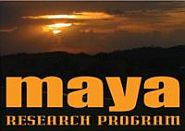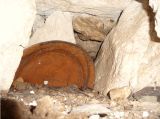
Chapter 2 | Chapter 3

This year the Maya Research Program finished excavations at an elite courtyard group in the Chum Balam-nal area of the ancient Maya city of Blue Creek. The Blue Creek site is a medium sized Maya city with several outlying residential zones, one of which is Chum Balam-nal. MRP has sponsored excavations in this area for the last two field seasons. This articled aims to give an overview of the completed excavations and detail some of the amazing finds discovered over the past few years.
In order to understand the setting in which the excavations took place two terms need to be defined. The first is courtyard group and the second is elite. A courtyard is one of the several identifiable building patterns that the Maya used to organize their extended family groups. A courtyard is bounded on four sides by structures and has limited access into the interior living space. In the case of the Chum Balam-nal Courtyard 13 group (CBN-13 group) an interior living space is surrounded by five structures with only two access points into the interior, a stairway leading to the south and another to the north. The enclosed living space and the limited access mean that the residents of the group had a good deal of privacy. A stranger could not walk into the central without permission.
The term elite carries various connotations, but in this case you can think of the residents as being well to do or upper class, but not members of the royal line that ruled the city of Blue Creek. They would have controlled certain resources, perhaps agricultural fields, water rights, lithic (stone) quarry sites, or some combination of the three.
Over the past three field seasons we have conducted intensive excavations on all of the main courtyard structures and have determined that four of the buildings functioned as residential structures, and the last was an ancestral shrine. The ancestral shrine was one of the buildings excavated this year. It is rectangular in shape and would have been constructed with two cut stone faced tiers when the courtyard was occupied. Ancestral shrines of this sort are common in the Blue Creek area and functioned as a memorial to honor or remember a person important to the people living in the courtyard. In the course of excavations a stone lined tomb was discovered under the floor of the structure. It contained an intact ceramic vessel and four pieces of jade.

Ceramic vessel and four pieces of jade.
In addition to the Shrine this year we also partially excavated the last remaining structure on the courtyard. It is located on the western end of the group and is composed of a large masonry, stone, room, built on top of a 2-foot high platform. We have been able to determine that the room functioned as a residential structure, someplace that served as a home for part of the extending family that lived and worked in the surrounding buildings. We were able to make this determination by looking both at the style of the architecture as well as the artifacts recovered during excavations. The room contained a low bench constructed from cut stones and covered with plaster. For the Maya, these benches functioned as both a sleeping area as a place to receive visitors. The artifacts included several metaté fragments and a broken mano. Metatés are large flat stones that were used with the mano to grind foods like corn and cacao. These items as well as other artifacts enable us to determine that the room was a living space.
We excavated under the bench discovered a small crypt. There were few artifacts associated with the burial, but we were able to recover two small bone beads and several fragments of pottery. Hopefully we will be able to determine the age of the burial once the artifacts are washed and analyzed.
Back to the Top
Chapter 2 | Chapter 3








